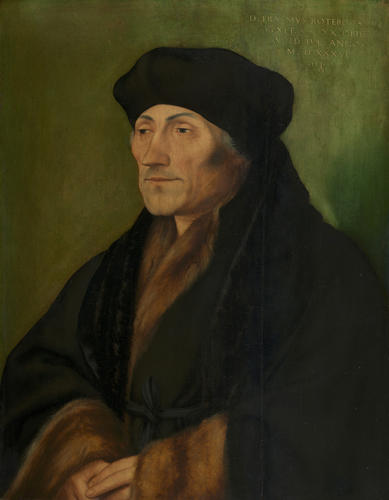-
1 of 253523 objects
Desiderius Erasmus (1466-1536) Signed and dated 1537
Oil on panel | 59.4 x 45.8 cm (support, canvas/panel/stretcher external) | RCIN 406202

Georg Pencz (c. 1500-1550)
Desiderius Erasmus (1466-1536) Signed and dated 1537
-
The painter and engraver Georg Pencz arrived in Nuremberg in 1523; it is assumed that he entered Albrecht Dürer’s workshop there, since he was friends with the engraver and etcher Sebald Beham (who was probably trained by Dürer) and his brother, the painter and engraver Barthel Beham. On 26 February 1525 all three, called the ‘godless painters’, were temporarily expelled from Nuremberg for disseminating radical reformist views concerning religion and government which opposed those promulgated by Luther. In 1529 Pencz married Margaretha, daughter of the artist Michel Graf. He may have travelled to Italy in the late 1520s, and again at the end of the 1530s or early 1540s, since the influence of Italian art on his subsequent work is strongly evident. In 1532 Pencz was granted an annual sum by the Council of Bürgermeisters and in 1555 was appointed court artist to Duke Albrecht of Prussia, but died on his way to Königsberg (now Kaliningrad). Famous for his large ceiling paintings with dramatic foreshortening, Pencz was also in demand as a portraitist. In his early portraiture the view is restricted to head and shoulders, as in Dürer’s works, but this format changed to larger, powerful three-quarter lengths in the 1540s. Pencz was often short of money, which is perhaps why he produced copies of portraits by other more famous artists, particularly those depicting famous sitters. In 1532 Prince Elector John the Magnanimous of Saxony commissioned from Pencz copies of Dürer’s portraits of the German emperors Charlemagne and Sigismund (Germanisches National Museum, Nuremberg), which are probably the portraits now in Schloss Glücksburg. In about 1533 Pencz copied Cranach’s portrait of Martin Luther dated 1528 (Raleigh, NC), of which many examples exist, such as that in the Schlossmuseum, Weimar, which was probably originally paired with a portrait of Luther’s wife Katharina von Bora, or of Melanchthon. In this case Pencz is copying Hans Holbein the Younger, who painted several different portraits of Erasmus in the early 1530s on his return to Basel from England. Holbein used his earlier portraits of Erasmus for this group, particularly the famous portrait dated 1523 (private collection, on loan to the National Gallery, London). This copy is closest to that by Holbein and his workshop of c.1530/31 (Ball State University Museum of Art, Muncie, IN) and another contemporary version in an American private collection. Both Holbein paintings, much smaller than Pencz’s copies, belonged to the Electors of Saxony, and the first may have been a present from Erasmus to the Elector. Pencz may have copied one of these portraits on his visit to the Saxon court to copy the Dürer portraits in 1532. At least five copies of this image by Pencz or his workshop exist. This one is dated 1537, the year after Erasmus’s death, when images of the scholar were much in demand. In his sixties, Erasmus has grey eyebrows and grey hair at his temples. His bone structure is visible in the thin face, sharp nose and narrow mouth. The scholar’s sensitivity and acute mind are still apparent in Pencz’s copy. He wears an unlined black gown on top of one lined with marten. Inscribed on the upper right: D. ERASMUS ROTERODAMVS / V XIT. AN. LXX. OBIIT / V. ID. IVL. ANNO. / M. D. XXXVI / 15 P / G 37 (PG in monogram) Catalogue entry adapted from The Northern Renaissance. Dürer to Holbein, London 2011
Provenance
Presented to Charles I in 1632; recorded in the King's Chair Room at Whitehall in 1639 (no 19); sold for £20 10s to Wright on 21 May 1650 from St James's Palace (no 213); recovered at the Restoration and listed in the King's Dressing Room at Hampton Court in 1666 (no 32)
-
Creator(s)
Acquirer(s)
-
Medium and techniques
Oil on panel
Measurements
59.4 x 45.8 cm (support, canvas/panel/stretcher external)
79.5 x 67.5 x 6.5 cm (frame, external)